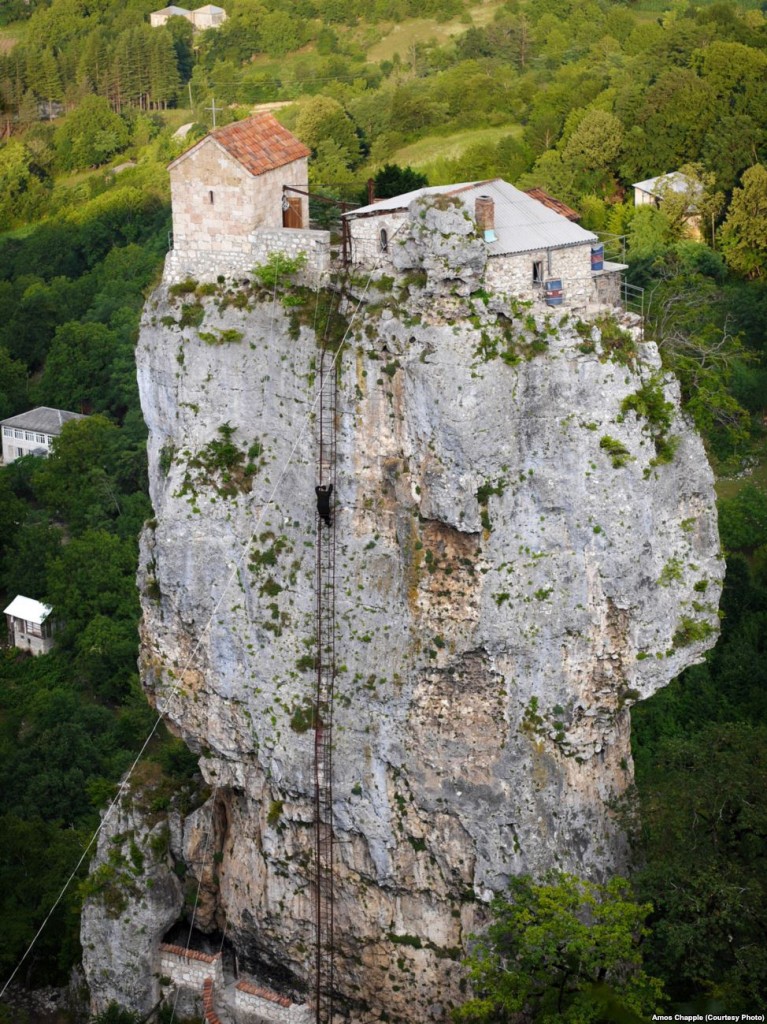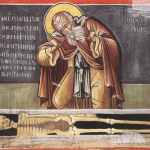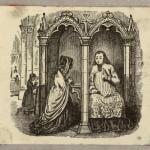I’m delighted by how many of you wrote in to tell me that “modern stylites” exist, after I referred to them hypothetically in the post on Orthodoxy and eating disorders. Here’s one of the best links you guys found:
Shortly after the collapse of communism and the resurgence of religion in Georgia, former “bad boy” Maxime Qavtaradze (now 59) decided to live atop the pillar in the way of the old stylites. “When I was young I drank, sold drugs, everything. When I ended up in prison…. It was time for a change. I used to drink with friends in the hills around here and look up at this place, where land met sky. We knew the monks had lived up there before and I felt great respect for them.” In 1993 Maxime took monastic vows and climbed the pillar to begin his new life. “For the first two years there was nothing up here so I slept in an old refrigerator to protect me from the weather.” Since then Maxime and the nearby Christian community have constructed a ladder to the top, rebuilt the chapel, and built a cottage where Maxime spends his days praying, reading, and “preparing to meet God.” As a result of the interest in the site there is now a religious community at the base of the pillar.
More pictures like the one below at the link.
And now, for a bit of cultural whiplash, let me give you an example of modernity being delightful: making ice sculptures with automated lathes:
(Found in the middle of a fascinating piece on the current state of ice sculpting — I did not know blowtorches play a part in the finishing process).
If you want to blend past and present in an enjoyable way, you might want to try “Two-Stroke Toilets” a science fiction story that appeared in Nautilus. I’m a little leery about summarizing without spoilering, so just give it five minutes and see if you’re enjoying it.
The next short story I have to recommend–“Good Night, Sweet Prince” by Rosamund Hodge–is self-summarizing, because here’s how it opens:
Stop struggling and listen: Once upon a time, there was a prince who wanted to marry Death.
You already know this won’t end well.
If you like her style, she’s also the author of Cruel Beauty and Gilded Ashes (a novella), which take fairytales (with all their original cruelty and grotesqueries) as the foundation for new stories.
The Shakespeare allusion in Hodge’s title isn’t accidental, but I was amused by a study that checked how hard it is to come up with Shakespearean language accidentally.
Some days ago I was talking with a friend about the infinite monkey theorem which is a funny interpretation of what thinking-in-infinite can produce. The same day, in my weekly English class, my teacher said that Anglo-saxon words do tend to be short, very often monosyllabic such as function words such as to, of, from etc and everyday words such as go, see run, eat, etc.
Both things made me think that a monkey could have easier to type a Shakespeare text rather than a Cervantes one. I cannot imagine a definitive way to demonstrate this but this experiment support my hypothesis. After simulating random words of 2, 3, 4 and 5 characters I look for them in English(1) and Spanish(2) dictionaries, which I previously downloaded from here. Result: I find more random words in the English one.
The research ends up being more a comment on English vs Spanish than Shakespeare vs Cervantes, but I like very much that the person turned their idle wondering into code. The author put up graphs, sources, and the code itself, so you can monkey around with it yourself.
Apropos of very little but it’s own delightfulness is the stop-motion video below (the model is also the artist).
Which might well put you in the mood to browse the year’s ten best optical illusions.
For more Quick Takes, visit Conversion Diary!














